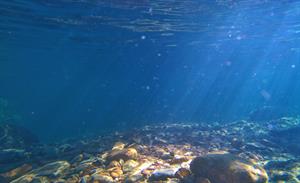PDF chapter test TRY NOW
One of the most remarkable facts about water is its power to carry silt or finely divided soil in suspension. This is the origin of the characteristic colour of the water in rainfed tanks. This colour varies with the nature of the earth in the catchment area and is most vivid immediately after a fresh inflow following rain. Swiftly flowing water can carry fairly large and heavy particles. The finest particles, however, remain floating within the liquid in spite of their greater density and are carried to great distances. Such particles are, of course, extremely small, but their number is also great and incredibly large amounts of solid matter can be transported in this way.
When silt-laden water mixes with the salt water of the sea, there is rapid precipitation of the suspended matter. This can be readily seen when one travels by steamer down a great river to the deep sea. The colour of the water changes successively from the muddy red or brown of silt through varying shades of yellow and green finally to the blue of the deep sea. That great tracts of land have been formed by silt thus deposited is evident on an examination of the soil in alluvial areas. Such land, consisting as it does of finely divided matter, is usually very fertile.
When silt-laden water mixes with the salt water of the sea, there is rapid precipitation of the suspended matter. This can be readily seen when one travels by steamer down a great river to the deep sea. The colour of the water changes successively from the muddy red or brown of silt through varying shades of yellow and green finally to the blue of the deep sea. That great tracts of land have been formed by silt thus deposited is evident on an examination of the soil in alluvial areas. Such land, consisting as it does of finely divided matter, is usually very fertile.
Explanation:
A distinguished fact about water is that it has the power to carry mineral sediments or fine particles of soil in a mixture state. This is how water gets its colour in the rainwater tanks. The colour keeps changing with the earth's different forms, in the tanks where rainwater is stored. It varies according to the different weather patterns - when there is fresh rain, the colour changes into brighter tones. Fast-moving water has the power to carry bigger and heavier particles, due to its force. But, the dissolved small particles keep moving within the water, even if it has greater volume; they travel to far distances. Such constituents - though small, they are higher in number and huge amounts of solid sediments travel in water through this method.

Silt-laden water - filled with nutrients and minerals!
When the water with soil and minerals mixes with the seawater, there is a swift action of precipitation. Precipitation means the water that falls as rain or snow, due to the chemical reactions in the environment. This action is very evident to our eyes when we travel by steamboats in huge rivers to the deep sea. The colour of the water also varies continuously from muddy red, brown(when silt is mixed in it) to different shades of yellow/green and finally becomes blue in the deep sea. A detailed study of the silt-deposited soil in such areas has revealed that the silt has thus formed vast areas of land. These lands are very fertile in nature.
Meanings of difficult words:
No. | Words | Meanings |
1 | precipitation | water that falls from the clouds towards the ground, especially as rain or snow |
2 | steamer | a ship, boat, or locomotive powered by steam |
3 | tracts | an area of land, typically a large one |
4 | alluvial | related to (alluvium) a deposit of clay, silt, and sand left by flowing floodwater in a river valley |
Reference:
State Council of Educational Research and Training (2019). Term-2 English Standard-9. Water - The Elixir of Life - Sir C.V. Raman (pp. 121-145). Published by the Tamil Nadu Textbook and Educational Services Corporation.
